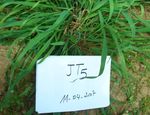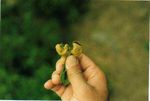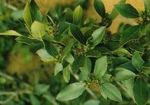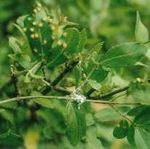Some recent Progress in Oat Crown Rust in Tunisia
←
→
Page content transcription
If your browser does not render page correctly, please read the page content below
Mini-Review Article
Some recent Progress in Oat Crown Rust in Tunisia
Mohamed Bechir Allagui, Institut National de la Recherche Agronomique de
Tunisie, Université de Carthage, Rue Hédi Karray, 2080 Ariana, Tunisia
ABSTRACT
Allagui, M.B. 2013. Some recent progress in oat crown rust in Tunisia. Tunisian Journal of Plant
Protection 8: 1-6.
Crown rust caused by Puccinia coronata f. sp. avenae is a major fungal disease of cultivated oats
(Avena sativa and A. byzantina) in Tunisia. Surveys conducted during different cropping seasons
showed that crown rust severity in farmer’s fields varied according to the year; the humid year
favorable to oat culture was also favorable to crown rust epidemics and vice versa mainly when the
year is too dry. The Pc gene differential oat lines, used by oat researchers to study the virulence pattern
in oat crown rust populations showed that the virulence phenotypes locally recorded are TJFR, TDFL
and TBLM; indicating that the Pc genes still expressing resistance to oat crown rust were Pc38, Pc39,
Pc52 and Pc68. Results on alternate host indicate that Rhamnus lycioides, a common and an endemic
forest Tunisian vegetation, is a new aecial host of oat crown rust and that the aeciospores released in
April and May represent the source of the fungus virulence diversity. Landraces of oats recently
collected from different regions were evaluated for leaf rusting and for agronomic traits. The results
suggest that vast areas in Tunisia are still rich with oat crown rust resistance as many landraces
displayed important agronomic traits and good resistance to crown rust making them useful in breeding
programs.
Keywords: Aecial host, Oat, Pc genes, Puccinia, resistance sources, Tunisia
Introduction maturing but susceptible to major foliar
Oats (Avena sativa and A. diseases. Crown rust, caused by Puccinia
byzantina) are the most important coronata f. sp. avenae, is the most
livestock feed in Tunisia grown over a widespread and damaging disease of oats
wide range of climatic conditions from (Avena spp.) in Tunisia. In 1990,
the humid and sub-humid to the semi-arid generalized crown rust epidemics caused
zones of the country (2). As early as the important yield losses ranging from 30 to
1960’s, two oat varieties were used; the 70% for the widely sown Australian
red local variety Creme (A. byzantina) cultivar Swan (3). Other destructive
which was susceptible to lodging and to crown rust epidemics were also observed
crown rust and Avon (A. sativa) in spring 1995 on the cultivar Mortlock
introduced since 1962 which was early from Australia. Due to the severe crown
rust epidemics related mainly to the
introduced oat cultivars, it was urgent to
Corresponding author: Mohamed Bechir Allagui undertake in Tunisia researches on oat
Email: allagui.bechir@gmail.com crown rust in order to study different
aspects of the disease and to look for new
Accepted for publication 30 April 2013
sources of resistance in the perspective of
releasing for growers oat varieties locally
Tunisian Journal of Plant Protection 1 Vol. 8, No. 1, 2013adapted and rust resistant. In this mini- The results showed that the Pc genes,
review, we reported the recent progress more resistant to oat crown rust in
achieved in oat crown rust under Tunisia, were Pc38, Pc39, Pc52 and
Tunisian’s conditions. Pc68. In previous evaluations carried out
in Tunisia in 2000, 2001 and 2002, the
Pc genes and virulence phenotypes lines Pc38, Pc39 and Pc68 were also
Sixteen single gene oat lines, as found to be resistant (1). These 3 genes in
the primary differentials, were sown early association were introduced in different
October 2002 in 4 field tests where agro- oat cultivars such as Ronald in Canada
ecological conditions ranged from humid (6). Our results on the effectiveness of the
(Sejnane) to sub-humid (Lafareg) and Pc genes are useful in particular when
semi-arid (Ariana and BouRabie). The oat importation of oat seeds from other
plants were subjected to crown rust countries is necessary. In this case, the
natural infections during the 2003 foreign oat varieties to be imported
growing season in order to assess with should have in the genotype Pc genes
time the most prevalent crown rust (Pc38, Pc39, Pc52 and Pc68) and
pathogenic variability. The differential preferably in association. Since many Pc
reactions were determined at the genes were found susceptible indicating a
maximum crown rust attack being in high crown rust pathogenic variability,
February for Sejnane, in March for durability of resistance is a crucial point
Ariana and in April for Lafareg and to be taken into account in oat crown rust
BouRabie (Table 1). The five lines Pc40, breeding programs.
Pc45, Pc46, Pc50 and Pc54 were heavily
infected at the 4 stations. Infection types Rhamnus lycioides, alternate host of
ranged between 3 and 4. These oat crown rust
differentials had on the leaf area, medium The limited resistance durability of the Pc
to large uredia without chlorosis. genes is often related to changes in
Reaction of the seven lines Pc48, Pc51, virulence phenotypes of the crown rust
Pc56, Pc58, Pc59, Pc62 and Pc64 varied fungus. In many countries including USA
with the station site. Most of them were and Canada, Rhamnus cathartica is
susceptible at Lafareg and Sejnane but considered a threat to agriculture due to
resistant at BouRabie and Ariana. The its potential as the principal alternate host
four differentials Pc38, Pc39, Pc52 and for the sexual stage of the oat crown rust
Pc68 were resistant at BouRabie and fungus giving rise to new pathogenic
Ariana sites. Nevertheless, only Pc39 was races through genetic recombination. This
susceptible in Sejnane but the proportion species (R. cathartica) has not been
of large uredia on leaves was small (1%); reported as a native plant in Tunisia
at Lafareg both Pc52 and Pc68 were despite the high rust virulence diversity
susceptible but with only few uredia on encountered. Our surveys, conducted in
leaves (1 and 5%, respectively). 2003 and 2004 in three sites in northwest
According to the nomenclature of Chong Tunisia, showed the presence of two
et al. (4), the reaction of the differentials Rhamnus species, R. lycioides and R.
indicated that the crown rust virulence alaternus (Fig. 1). No crown rust
phenotypes prevalent in Tunisia during structures were found on R. alaternus
the 2003 growing season ranged from suggesting it as a non-host of oat crown
TFRT at Lafareg, to TJFR at Sejnane, to rust under natural conditions of Tunisia.
TDFL at Ariana to TBLM at BouRabie. However, spermogonia and aecia were
Tunisian Journal of Plant Protection 2 Vol. 8, No. 1, 2013Table 1. Infection types and visual estimates of crown rust uredia rate on leaf area of the 16 Pc gene lines in 4
experimental stations. Plant reactions were observed at heading to milk stages to crown rust natural infections
Pc gene lines
Station
Pc Pc Pc Pc Pc Pc Pc Pc Pc Pc Pc Pc Pc Pc Pc Pc
Rate (%)
38 39 40 45 46 48 50 51 52 54 56 58 59 62 64 68
; 3 3 4 4 4 3 2 1 3 4 4 3 2 3 ;
Sejnane
0 1 20 40 30 10 5 1 1 10 5 1 10 5 5 0
; 2 4 4 4 4 4 2 2 4 2 4 4 2 2 ;
Ariana
0 1 60 60 60 60 60 1 0.1 70 1 10 10 0.1 1 0
; ; 4 4 4 2 4 3 2 4 2 2 ; 2 4 ;
BouRabie
0 0 60 30 30 5 10 1 1 60 1 1 0 5 60 0
0-; 1 4 4 4 4 4 4 3 4 4 2 4 4 4 4
Afareg
0 1 80 40 80 10 60 20 1 70 20 5 1 20 30 5
0 = no macroscopic signs of infection, ; = only necrotic or chlorotic flecks, 1 = small uredia surrounded by chlorosis
or necorosis, 2 = small to medium-size uredia in cholorotic area, 3 = medium-size uredia in cholorotic area, 4 =
large uredia without necrosis or chlorosis (4).
found on many plants of R. lycioides generally is not involved in the
during the spring period and aeciospores epidemiology of crown rust in areas
collected from the aecia on the leaves where winters are relatively mild and
produced the typical symptoms of oat where summers are long and hot. Such
crown rust on susceptible oat plants. The conditions are similar to those of the
result suggests that R. lycioides in Tunisia coastal areas of Tunisia. However, in the
is a new aecial host of oat crown rust northwest of Tunisia (Beja and Jendouba)
involved in the oat crown rust life cycle with extreme winters, aeciospores wind-
(7). From an epidemiological point of transported from R. lycioides are likely to
view, urediospores on volunteer and wild initiate oat crown rust epidemics because
oat plants could initiate oat crown rust the disease frequently appears on
epidemics as early as November because commercial oats in April and May when
early plantings are highly receptive to the aeciospores are released. It is
early oat crown rust attack, particularly in expected to found more crown rust
Tunisia’s coastal area away from the virulence phenotypes in the oat fields
mountains harboring the Rhamnus species alongside the Rhamnus species.
(1). Simons (10) reported that Rhamnus
(A) (B) (C)
Fig. 1. A: Leaves of Rhamnus lycioides showing orange yellow aecia containing the aeciospores of the crown rust
agent, B: Hypertrophied young leaves of R. lycioides highly colonized by aecia and aeciospores of the crown rust
agent, C: R. alaternus is non-host of crown rust in Tunisia (7).
Tunisian Journal of Plant Protection 3 Vol. 8, No. 1, 2013Evaluating landrace oats for crown crown rust until 2006. This is probably
rust resistance due to perpetual changes in the local
Researches on resistance sources population of oat crown rust, at least, by
to oat crown rust in spontaneous oat the aecial host R. lycioides present in the
accessions have been performed since northwest of Tunisia (7). In addition to
2002. From several accessions collected rust resistance, the hexaploid oat
from different localities in Tunisia, at accessions JT0 and JT5 were characterized
least three accessions were found by their interesting agronomic traits
possessing a high level of resistance to making them a valuable materiel
the local crown rust agent populations (8). potentially useful in breeding programs
These resistant accessions were (9). Numerous studies in this direction
originated from sites in the north zone of and practical results of oat breeding have
Tunisia suggesting that these areas are evidenced that utilization of spontaneous
rich with oat crown rust resistance. The species along with cultivated varieties is
three resistant oat accessions JT5, JT0, the most promising trend of oat breeding,
MtK2 (Fig. 2) exhibited a low Area Under allowing broadening genetic base and
Disease Progress Curve (AUDPC) value, reducing genetic erosion of this crop (5).
a longer latent period, a restricted However, the genetic control of crown
uredium size and a lower rate of rust resistance in these oat landraces is
uredia/cm2. During multiple trials over not yet identified, so more researches are
years, it was found that from nine needed on this material to reveal the
accessions observed resistant in 2003, nature of crown rust resistance (mono- or
only three maintained their resistance to polygenic).
Fig. 2. Resistant hexaploid oat landraces JT0 and JT5 to crown rust and susceptible cultivar Av.95 (in the center).
Note in the resistant landraces the very few uredia surrounded by necrotic zones, compared to the susceptible one
with numerous uredia well developed on the leaf areas.
Future perspectives molecular markers linked to such
The research currently underway resistance are intended to be developed.
concerns the genetic control of crown rust Surveys over years on changes of oat
resistance in the selected hexaploid oat crown rust virulence phenotypes are
landraces by crossing them with local another ongoing subject related to
cultivars. Based on segregating families, resistance durability. Tentative to
Tunisian Journal of Plant Protection 4 Vol. 8, No. 1, 2013introduce slow rusting into oat cultivars is management practices of oat production
a hopeful challenge for the future. are presently under study at a practical
Besides these pathological aspects, seed level especially for the newly released oat
production technology and improved varieties.
RESUME
Allagui M.B. 2013. Quelques progrès récents sur la rouille couronnée de l’avoine en Tunisie.
Tunisian Journal of Plant Protection 8: 1-6.
La rouille couronnée causée par Puccinia coronata f. sp. avenae est une maladie fongique importante
sur les cultures d’avoine (Avena sativa et A. byzantina) en Tunisie. Des prospections conduites pendant
plusieurs saisons de culture ont montré que la sévérité de la rouille couronnée dans les champs
commerciaux varie en fonction de l’année; l’année humide favorable à la culture de l’avoine est
également favorable aux épidémies de la rouille couronnée et vice versa surtout si l’année est fortement
sèche. Les lignées différentielles d’avoine, portant des gènes Pc, utilisées pour étudier le modèle de
virulence chez les populations de la rouille couronnée, ont montré que les phénotypes de virulence
localement détectés ont été TJFR, TDFL et TBLM; indiquant que les gènes Pc encore résistants à la
rouille couronnée sont Pc38, Pc39, Pc52 et Pc68. Les résultats sur l’hôte secondaire indiquent que
Rhamnus lycioides, une plante endémique dans la végétation forestière tunisienne, est un nouvel hôte
écidien de la rouille couronnée de l’avoine dont les écidiospores sont libérées en avril et mai
constituant ainsi une source de la diversité dans la virulence de ce champignon. Des écotypes d’avoine,
récemment collectés de différentes régions, ont été évalués pour le feuillage rouillé et des traits
agronomiques. Les résultats suggèrent que de vastes zones en Tunisie sont encore riches avec des
résistances à la rouille couronnée puisque divers écotypes montrent des traits agronomiques importants
et une bonne résistance à la rouille couronnée. Ces écotypes peuvent être utiles dans des programmes
d’amélioration.
Mots clés: Avoine, gènes Pc, hôte écidien, Puccinia, sources de résistance, Tunisie
.'( ) ُ# ا/ن ا لا أا ! ت ا# ا$%& .2013 . ا ،
Tunisian Journal of Plant Protection 8: 1-6.
اوة ا !" ا ! اض اPuccinia coronata f. sp. avenae ا ا ي ّا أا
./ا%! ل ة12 3 ت أ5%6! ت7 أظ.+,% ﺗ$ (Avena sativa وA. byzantina) '( ُ* ا/ ن$%& ا
ةBB ات ا%A6 ا3, *$ . ى2 A/ "! ( ة9 ! ن$%& ل ا%*5 $ أا : : ;LITERATURE CITED
1. Allagui, M.B., Ahmed, A.S., and Chakroun, M. 2002. La rouille couronneé de l’avoine en Tunisie: effet de la
date de semis et efficacité des gènes Pc de résistance. Ann. INRAT 75: 205-221.
2. Al Faïz, C., Chakroun, M., Allagui, M.B., and Sbeita, A. 2004. Fodder oats in the Maghreb. Pages 53-69. In:
Fodder Oats: A World Overview. Suttie, J.M., Reynolds, S.G., Eds. FAO, Rome, Italy.
3. DGPA, 1990. Rapport élaboré par le comité chargé de l’évaluation des dégâts causés par les maladies
cryptogamiques sur les cultures fourragères (avoine et vesce avoine). Direction Générale de la Production
Végétale (DGPA, Ministry of Agriculture) Tunisia, 9 pp.
4. Chong, J., Leonard, K.J., and Salameron, J.J. 2000. A North American system of nomenclature for Puccinia
coronata f. sp. avenae. Plant Dis. 84: 580-585.
5. Loskutov, I.G. 2002. Avena wild species is a source of valuable characters in oat breeding. Oat Newsletter.
Available online: http://wheat.pw.usda.gov/ggpages/oatnewsletter/v48/wild.htm
6. Mitchell Fetch, J.W., Brown, P.D., Duguid, S.D., Chong, J., Haber, S.M., Menzies, J.G., Ames, N.P., and Fetch,
Jr. T.G. 2003. “Ronald oat”. Can. J. Plant Sci. 83: 101-104.
7. Hammami, I., Allagui, M.B., Chakroun, M., and El Gazzeh, M. 2006. Rhamnus lycioides in Tunisia is a new
aecial host of oat crown rust. Eur. J. Plant Pathol. 115: 357-361.
8. Hammami, I., Allagui, M.B., Chakroun, M., and El Gazzeh, M. 2007. Evaluating landrace oats (Avena spp.)
collected in Tunisia for crown rust resistance under natural infection. Euphytica 157: 27-34.
9. Hammami, I., Allagui, M.B., Chakroun, M., and El Gazzeh, M. 2008. Agronomic characterization of Tunisian
spontaneous oat accessions resistant to oat crown rust and potential in plant breeding. Tunisian J. Plant Prot. 3:
1-9.
10. Simon, M.D. 1985. Crown rust. Pages 131-172. In: The Cereal Rusts (Vol 2). Roelfs, A.P., Bushnell, W.R., Eds.
Academic Press, Orlando, FL, USA.
-----------------------
Tunisian Journal of Plant Protection 6 Vol. 8, No. 1, 2013You can also read



























































